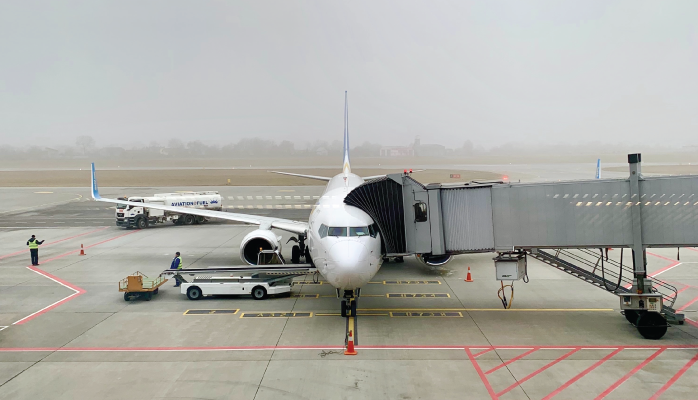What Is an Aviation Safety Management System (SMS)?

An aviation safety management system (SMS) has been repeatedly defined as a formal, systematic approach to managing safety, including necessary
- organizational structures,
- accountabilities,
- policies, and
- procedures.
Implementing an SMS offers aviation service providers a simple, organized approach to preventing accidents, incidents, and irregularities. But there are more benefits to implementing an SMS. Furthermore, there are other opportunities available as you address SMS regulatory requirements.
Related Aviation SMS Implementation Articles
- Why Should We Implement Aviation SMS?
- How to Start an Aviation SMS Implementation - With Resources
- How to Create Aviation SMS Implementation Plan - With Templates
Implementing Aviation SMS Is Good Business
SMS is considered smart business management with incredible potential to reduce risk to assets. Successfully implemented SMS improves safety performance, which consequently leads to a more profitable business. SMS is a process.
SMS is your tool. Just like any other tool, SMS only works if you work it according to the established design principles - and these principles make sense and are rather easy to adopt for all but the most toxic safety cultures.
In short, SMS:
- Saves money;
- Protects employees and customers;
- Improves processes and procedures; and
- Makes your business more predictable.
But there are many risks to both
- immature, developing SMS implementations and
- mature aviation SMS.
Who Is Required to Implement Aviation SMS Programs?
SMS is not just for airlines and airports. The International Civil Aviation Organization (ICAO) requires safety management system implementation by the following aviation service providers:
- Aircraft operators;
- Aircraft maintenance organizations (AMOs or MROs);
- Air navigation services providers;
- Aircraft and aircraft equipment manufacturers;
- Flight schools; and
- Airport operators.
Since November 2006, aviation service providers that operate under the jurisdiction of ICAO member states have been required to implement formal aviation SMS. The United States took the exception with the ICAO mandate and subsequently delayed SMS implementations. However, there were a couple of U.S. voluntary SMS initiatives that many airlines, airports, and charter operators participated. These were called "SMS Pilot Projects."
In January 2015, SMS became required for part 121 operators in the United States. We can expect U.S. airports and charter operators to follow next. Aviation maintenance organizations always seem to follow airports and part 135 charter operations.
Many proactive FBOs also have implemented SMS, though I have not heard of much regulatory oversight with FBOs yet.
If you are in the United States, FAA safety professionals prefer to call aviation safety management systems "SMS" and not "SMS program." They want to differentiate SMS as a system and not just another one of the FAA's multitude of "programs."
The FAA folks can become very insistent when you call SMS an "SMS program." You may notice that we are trying not to offend the FAA any longer and are reworking many of our materials to align with FAA preferences. Personally, it really doesn't matter much to me, but I know that when safety managers are searching the web for training and resource materials for their SMS implementations, they will naturally search for "aviation SMS", "aviation SMS program" or "SMS program."
At your company, call SMS whatever gets the point across. SMS for the layman means "short messaging service" which is the technology behind text messaging. The point is that if you are speaking to an FAA inspector and you say "SMS program," don't be surprised by an upraised eyebrow or an indignant comment that "SMS is not a program, it is a system." I say "Fine, call a dog a chicken, but the dog will still taste like a dog." I could argue this point in other ways, but what's the point? I'll call it an SMS in the interest of being a "team player."
Related Aviation SMS Implementation Articles
- 3 Myths About Aviation SMS Implementation
- Is Your Aviation SMS Implementation a Farce? - With Self-Assessments
- Overview of 4 Phases of Aviation SMS Implementation With Free Resources
How SMS Compare to QMS?

Many mid-sized to larger aviation organizations readily see the benefits of Quality Management Systems (QMS). In fact, there is less resistance to implementing QMS than SMS.
So how does an SMS relate to a QMS? An SMS contains many of the same elements of a QMS, yet focuses on safety. While QMS programs focus on internal quality assurance procedures and are customer-focused, an SMS enhances the QMS by adding a risk-based approach to the
- structure,
- responsibilities,
- processes, and
- procedures of the operator.
Super-charged QMS can meet SMS expectations while providing:
- SMS compliance;
- Increased effectiveness; and
- Assurance of high safety performance standards.
It will be easier to implement an SMS if you already have QMS. There will be less resistance to change from upper-level management as they already understand how predefined, industry-accepted practices add "financial" value to operations.
When an operator does not have an existing QMS and is in the process of implementing an aviation SMS, the operator should be encouraged to think outside the box and incorporate QMS features and processes into the SMS. Otherwise, the operator is wasting an opportunity to use a very solid risk management methodology to improve operations from a different perspective, including:
- Security;
- Environmental;
- Quality; and even
- HR processes.
An SMS can be considered the bonafide, but benevolent Trojan Horse, but inside is not a bunch of Greek warriors ready to jump out, or a virus that will harm computers. This SMS Trojan Horse, once implemented in an organization, can be used to improve processes and procedures that extend beyond the standard SMS regulatory requirements. There are hidden, business-improvement gifts awaiting aviation service providers.
But first, they need to change their mindset from:
- → I have the regulator's foot on the back of my neck making me spend time and money on this "SMS thing."
to
- → This SMS thing makes very good business sense and if we work the steps, we can become more profitable and safe at the same time.
Related Articles on Integrated QMS and SMS
- QMS Programs vs Aviation Safety Management Systems (SMS)
- 5 Easy Ways to Combine QMS and SMS in Aviation Operations
- Moving From Quality Management to Integrated SMS and QMS Systems
The Good News About SMS Implementations
For safety managers facing management resistance toward SMS implementations, there is good news. There are many common elements to SMS and QMS programs. Aviation service providers with functioning QMS programs are already most of the way towards SMS implementation.
Improving your safety culture will come naturally with the SMS implementation, including:
- Reduction in hazards;
- Better, more effective risk controls and procedures;
- Fewer accidents, incidents and close calls; and
- Enhanced employee morale.
There are more benefits of aviation SMS implementations, but I'm sure you are tired of reading about these benefits in regulatory documentation.
Eating the Aviation SMS Elephant
Implementing a fully functioning aviation SMS may appear daunting to most safety managers. Empirical evidence suggests that three to five years are required for most aviation cultures to accept the "new way of doing business," that is,
- Healthy safety reporting culture;
- Organized and systematic treatment of hazards;
- Assuring continuous improvement of the SMS; and
- Developing habits of regular safety promotion activities.
Aviation SMS are elephants when one considers all the elements in the four pillars. But just like eating an elephant one bite at a time, SMS implementations are manageable by breaking up the SMS implementation into smaller tasks. SMS are marathons, not sprints.
Related Articles on Aviation SMS Four Pillars
- What Are the 4 Pillars of SMS?
- Who Started Four Pillars of Safety Management in Aviation
- Which of the Four Pillars of SMS Carries the Most Weight?
Final Thoughts on Using QMS to Implement SMS

SMS is a requirement for most aviation service providers. This does not negate the resistance safety managers face from other managers.
For many managers outside the safety department, "SMS requirements" are the safety department's problem. One effective strategy that helps minimize resistance to SMS implementations is to equate the benefits of SMS to QMS.
Showing management that SMS makes good business sense logically helps reduce resistance to regulatory requirements demanded by an SMS. This is particularly important when the safety team is competing with a budget!
Why should we implement SMS programs? If you can answer this question convincingly to other managers, you have one required skill to become a safety manager.
While QMS focuses on customers and quality control, aviation SMS places focus on "safety" using prescribed risk management processes. Safety risk management (SRM) and safety assurance (SA) processes are distinct differences in the SMS. SMS shifts management's focus from quality-control processes to addressing the repeatable, circular process of:
- system design and analysis as they relate to safety;
- proactive hazard identification;
- safety risk analysis and assessment;
- detective and preventive risk controls;
- implementation of new or modified systems;
- monitoring the system for safety-concerns;
- safety reporting when substandard performance is detected or unidentified hazards detected; and
- repeat.
The last paragraph sums up the high points that differentiate SMS from QMS. Policy and promotion are common elements of not only QMS but every ISO standard, including quality, environmental and health and medical.
For operators who have a fully functioning QMS, you should focus on SMS documentation requirements from the perspective of how to use existing data management systems to capture and manage all the SMS documentation. You can expect SMS auditors to come to visit your operation.
Consider how you plan on providing auditors a view of your SMS without confounding and overwhelming them with QMS data. If you have a flexible database that allows an administrator to isolate and categorize safety-related details from quality, then you are off to a good start.
A foreseeable challenge will be that the SMS' SRM and SA processes may not be easily managed in existing QMS data management tools. In this case, you have two options:
- Have your in-house developers implement tools to manage and monitor SMS documentation requirements; or
- Adopt another database that supports both QMS and SMS.
If you need an SMS database that is flexible enough to capture QMS data as well as SMS, environmental, and HR (and other) requirements, then you may consider SMS Pro. Below are some short videos to explore the system. You may also learn what is actually involved in an SMS by reviewing these demo videos. After watching these demo videos, you may want to see a live demo where you can ask questions.
Related SMS Documentation Articles
- Best Practices for Documenting Your Aviation SMS
- How to Document Your System Processes in Aviation SMS
- 5 Times Documentation Saves Safety Managers in Aviation SMS
We are here to help. We want to be your SMS partner.
Live SMS Pro Demo
No strings attached. Schedule a live demo when it is convenient for you.
Last updated December 2025.








